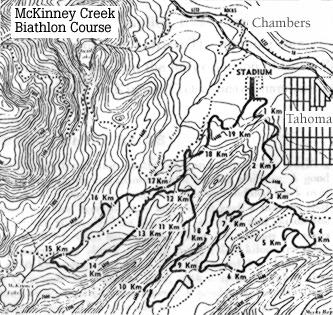

Races started and finished at a temporary stadium constructed along what is now Gray Avenue in Kailua Park, just west of Tahoma. Race courses varying in length from 5 km to 50 km fanned out from this site, stretching from what is now Sugar Pine Point State Park to Homewood. Timing buildings and aid stations dotted the area. Remnants of these hand hewn log structures can still be found.
One race course, the 20 km ski and shoot biathlon, meandered through Westlake Village, dropped down into Sugar Pine Point State Park, climbed back toward McKinney Lake, then descended quickly through McKinney Estates. In 1960, these two subdivisions and the park did not exist. Shooting ranges were located on the flat, open meadow along General Creek and in cleared areas along the McKinney-Rubicon Springs Road. Spent rifle cartridges and rusted target fragments are still visible on the ground along with now battered log bridges over General Creek. The biathlon event was the first ever for the Olympics.
The Westshore with its early abundant snowfall and rolling terrain is ideally suited for cross-country skiing. Olympic ski trails were narrow, single lane parallel tracks. Skating technique and the wider, modern trails were unknown. Trails did not follow the web of abandoned logging roads, but instead meandered along land contours, slipping through narrow corridors carved through the forest.
The Tahoe Sierra State Parks Foundation has expressed interest in resurrecting at least part of the historical Olympic ski trails in and around Sugar Pine Point State Park. Foundation members envision an historically accurate reconstruction of trails complemented with interpretive displays and distance markers. The trails would be suitable for diagonal stride cross-country skiing and snowshoeing. The park staff believes it may be permissible to display the Olympic rings logo at the trailhead to the current cross-country trail system at the campground area. International cross-country ski consultant John Frado viewed the former Olympic terrain in February 1999 and declared it highly suitable for world class cross-country ski trails. In July 1999, the State Parks Foundation will consider funding a feasibility study on recreating some of the key features of the Olympic cross-country course together with historical and natural interpretive elements.
Development of Squaw Valley and reminisces over the Squaw Valley Olympic events have now overshadowed the quaint, but not forgotten cross-country history of the Westshore. Prideful, a few knowing cross-country ski enthusiasts can still recall a time when the Westshore stood in the world class spotlight of Olympic cross-country skiing and hope for its speedy return to prominence.
David C. Antonucci is an avid cross-country skier and 24 year Tahoe resident. He serves on the board of the Tahoe Sierra State Parks Foundation and resides on the Westshore with his wife and son.
If you have historic information artifacts/memorabilia regarding West Shore
venues of the 1960 Olympics, please contact: David
C. Antonucci
First Day of Issue 1960 Olympics - envelope above from the collection of Jill Beede.

Tahoe
Country / Pays de Tahoe ©1996-2003 (Jill Beede)